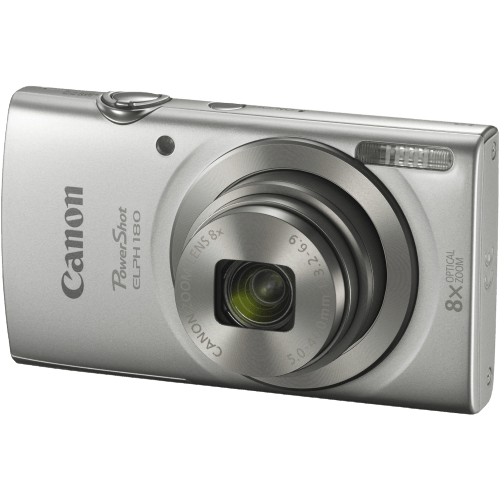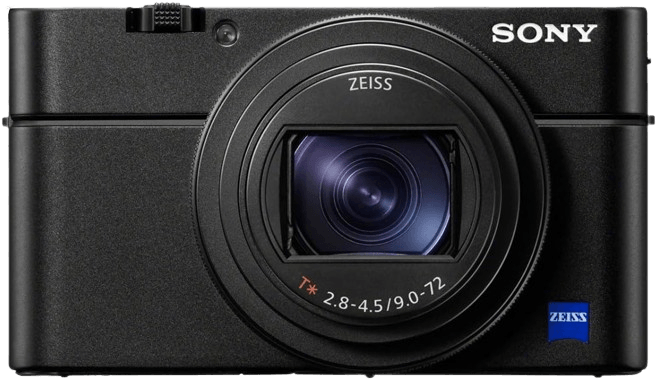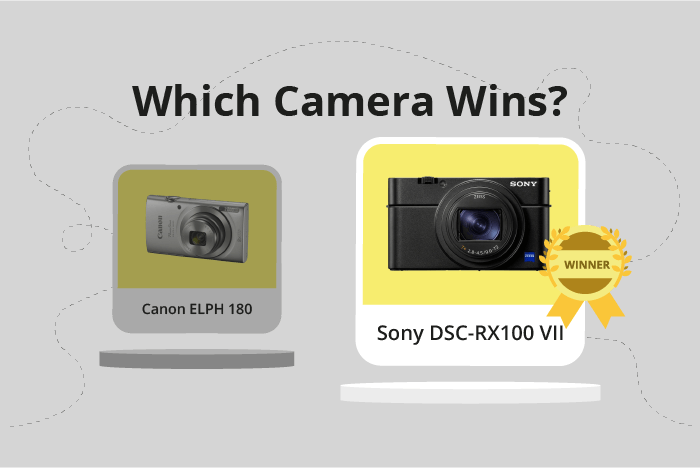Canon PowerShot ELPH 180 vs Sony Cyber-shot DSC-RX100 VII Comparison
Canon PowerShot ELPH 180

Sony RX100 VII

The Sony Cyber-shot DSC-RX100 VII outperforms the Canon PowerShot ELPH 180 with a score of 60/100 compared to 46/100. Both cameras share the compact camera type and similar launch prices, with the Sony model being released in 2019 and the Canon model in 2016.
The Sony RX100 VII’s higher score is due to its more advanced features, better performance, and overall higher quality. On the other hand, the Canon ELPH 180 is lighter, weighing 126g compared to Sony’s 302g, making it easier to carry around.
Taking into account the specifications and scores, the Sony RX100 VII is the superior choice for those seeking higher quality and more advanced features. However, the Canon ELPH 180 may be a better option for users prioritizing portability and a lower price point.
Canon PowerShot ELPH 180 vs Sony Cyber-shot DSC-RX100 VII Overview and Optics
The Sony Cyber-shot DSC-RX100 VII wins in the optics comparison with a score of 61/100, while the Canon PowerShot ELPH 180 scores 53/100. Both cameras share some common specifications, such as having 20 megapixels, fixed lens mounts, and image stabilization. However, there are notable differences in their shooting speeds, sensor types, processors, DXOMARK scores, sensor sizes, and aspect ratios.
The Sony Cyber-shot DSC-RX100 VII outperforms the Canon PowerShot ELPH 180 in several aspects. Its shooting speed is significantly faster at 5 compared to the Canon’s 0.8. This allows for better capturing of fast-moving subjects. The Sony camera also has a larger sensor size of 1″ versus the Canon’s 1/2.3″, providing better image quality and low-light performance. Additionally, the Sony camera has a 3:2 aspect ratio, which is preferred by some photographers for better framing options.
On the other hand, the Canon PowerShot ELPH 180 has some advantages over the Sony Cyber-shot DSC-RX100 VII. Its sensor type is CCD, while the Sony camera uses a CMOS sensor. CCD sensors generally produce less noise and better image quality, although they may not perform as well in low-light conditions. Moreover, the Canon camera has a higher DXOMARK score for the sensor, at 66 compared to the Sony’s 63, indicating a marginally better sensor performance.
In terms of processors, the Canon PowerShot ELPH 180 uses a Digic 4+ processor, while the Sony Cyber-shot DSC-RX100 VII uses a Bionz X processor. The Bionz X processor is known for its fast processing speed and enhanced image quality, giving the Sony camera an edge in this area.
Taking all factors into consideration, the Sony Cyber-shot DSC-RX100 VII emerges as the better camera in terms of optics, with advantages in shooting speed, sensor size, and processing power. However, the Canon PowerShot ELPH 180 still holds its ground with a slightly better sensor performance and lower noise levels. Ultimately, the choice between these two cameras will depend on the specific needs and preferences of the photographer.
Canon PowerShot ELPH 180 vs Sony Cyber-shot DSC-RX100 VII Video Performance
The Sony Cyber-shot DSC-RX100 VII outperforms the Canon PowerShot ELPH 180 in video capabilities with a significantly higher score of 91/100 compared to the ELPH 180’s 34/100. Both cameras share some common features, such as the ability to record videos and capture images, but the RX100 VII boasts more advanced specs, making it the superior choice for video enthusiasts.
The RX100 VII’s video quality is superior, offering 4K resolution (3840 x 2160) as opposed to the ELPH 180’s standard HD (1280 x 720). This means that the RX100 VII can capture more detail and produce sharper, more vibrant videos. Furthermore, the RX100 VII has a higher maximum video frame rate of 120fps, allowing for smoother slow-motion footage and better action shots than the ELPH 180, which has a maximum frame rate of 30fps. Additionally, the RX100 VII has built-in time-lapse functionality, which the ELPH 180 lacks.
The ELPH 180, however, is more affordable and compact, making it an attractive option for those on a budget or who prioritize portability. While its video capabilities are not as advanced as the RX100 VII’s, it can still capture decent quality footage for casual users.
Taking these factors into account, the Sony Cyber-shot DSC-RX100 VII is the clear winner in terms of video capabilities, providing higher resolution, a faster frame rate, and time-lapse functionality. The Canon PowerShot ELPH 180, while not as advanced in video performance, remains a viable option for those prioritizing affordability and compactness.
Canon PowerShot ELPH 180 vs Sony Cyber-shot DSC-RX100 VII Features and Benefits
The Sony Cyber-shot DSC-RX100 VII outperforms the Canon PowerShot ELPH 180 in features, scoring 68 out of 100 compared to the ELPH 180’s score of 34. Both cameras share some common specifications, such as having WIFI capabilities and lacking GPS functionality.
The RX100 VII surpasses the ELPH 180 in several aspects. It has a larger screen size of 3 inches compared to the ELPH 180’s 2.7 inches. The screen resolution on the RX100 VII is also significantly higher, boasting 921,000 dots versus the ELPH 180’s 230,000 dots. Additionally, the RX100 VII features a touchscreen and a flip screen, making it more versatile and user-friendly. Furthermore, the RX100 VII includes Bluetooth connectivity, which the ELPH 180 lacks.
Despite its lower score, the Canon PowerShot ELPH 180 still has some advantages over the RX100 VII. It is a more affordable option for those on a budget, while still offering solid performance and image quality. However, its features are not as advanced as those found in the Sony RX100 VII.
Taking these factors into account, the Sony Cyber-shot DSC-RX100 VII emerges as the superior camera in terms of features, with its larger and higher-resolution touchscreen, flip screen, and Bluetooth connectivity. The Canon PowerShot ELPH 180, on the other hand, is a more budget-friendly option with decent performance but less advanced features.
Canon PowerShot ELPH 180 vs Sony Cyber-shot DSC-RX100 VII Storage and Battery
The Sony Cyber-shot DSC-RX100 VII wins in the storage and battery category with a score of 29/100, while the Canon PowerShot ELPH 180 scores 27/100. Both cameras have one memory card slot and support USB charging. They also accept SD, SDHC, and SDXC cards. However, the Sony camera additionally supports Memory Stick Pro Duo cards, giving it a slight edge in storage options.
The battery life of the Sony camera is superior, with 260 shots per charge compared to the Canon’s 220 shots. The Sony uses an NP-BX1 battery, while the Canon uses an NB-11LH battery. This longer battery life gives the Sony camera an advantage in extended shooting situations.
The Canon camera does not offer any significant advantages in the storage and battery category. Its performance is slightly lower than the Sony camera in terms of battery life and storage options.
Taking these factors into account, the Sony Cyber-shot DSC-RX100 VII is the better option for storage and battery capabilities, while the Canon PowerShot ELPH 180 falls short in this comparison.
Canon PowerShot ELPH 180 vs Sony Cyber-shot DSC-RX100 VII – Our Verdict
Are you still undecided about which camera is right for you? Have a look at these popular comparisons that feature the Canon PowerShot ELPH 180 or the Sony Cyber-shot DSC-RX100 VII:
- Ricoh GR IIIx vs Sony Cyber-shot DSC-RX100 VII
- Canon PowerShot G7 X Mark III vs Sony Cyber-shot DSC-RX100 VII
- Canon PowerShot G5 X Mark II vs Sony Cyber-shot DSC-RX100 VII
- Panasonic Lumix ZS200 (TZ200) vs Sony Cyber-shot DSC-RX100 VII
- Canon PowerShot G1 X Mark III vs Sony Cyber-shot DSC-RX100 VII
- Canon EOS R50 vs Sony Cyber-shot DSC-RX100 VII

